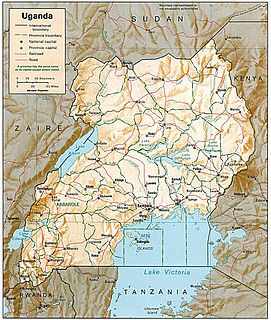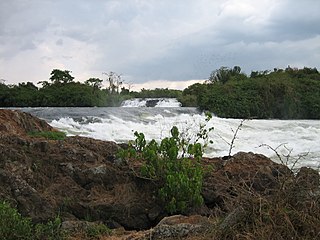
Transport in Uganda refers to the transportation structure in Uganda. The country has an extensive network of paved and unpaved roads.

The Ssese Islands are an archipelago of eighty-four islands in the northwestern part of Lake Victoria in Uganda. The islands are coterminous with the Kalangala District in southern Central Uganda, which does not have any territory on mainland Uganda.

Kalangala, also known as Ssesse, is a district in Central Uganda. The district is coterminous with the Ssese Islands in Lake Victoria and does not have territory on mainland Uganda. Like other Ugandan districts, it is named after its 'chief town', Kalangala which is located on Bugala Island, the largest of the Ssese Islands.
Kalangala is a town in Kalangala District in the Central Region of Uganda. It is the headquarters of the district.
Articles related to Uganda include:

Burning of renewable resources provides approximately 90 percent of the energy in Uganda, though the government is attempting to become energy self-sufficient. While much of the hydroelectric potential of the country is untapped, the government decision to expedite the creation of domestic petroleum capacity coupled with the discovery of large petroleum reserves holds the promise of a significant change in Uganda's status as an energy-importing country.

The Ministry of Energy and Mineral Development, also Ministry of Energy, Oil and Mineral Development is one of the governmental bodies of Uganda. The ministry has the function of developing and implementing policies related to electricity, minerals, petroleum and petroleum products. The ministry is part of the national cabinet and is headed by a cabinet minister. The current Cabinet Minister of Energy is [Hon. Ruth Ssentamu Nankabirwa].
Stanbic Bank Uganda Limited (SBU) is a commercial bank in Uganda and is licensed by the Bank of Uganda, the national banking regulator.

The Bujagali Power Station is a hydroelectric power station across the Victoria Nile that harnesses the energy of its namesake; the Bujagali Falls, in Uganda. Construction began in 2007 and concluded in 2012. It was officially inaugurated on 8 October 2012 by Ugandan President Yoweri Museveni and Aga Khan IV in the presence of African politicians and investors.
The National Water and Sewerage Corporation (NWSC) is a water supply and sanitation company in Uganda. It is wholly owned by the government of Uganda.
Tororo Thermal Power Station is a 89 MW (119,000 hp) heavy fuel oil-fired thermal power plant located in the town of Tororo in Tororo District in the Eastern Region of Uganda.
Bugala Power Station is a 1.5 megawatts (2,000 hp) biodiesel-fired thermal power plant located on Bugala Island, in Kalangala District, in the Ssese Islands Archipelago, on Lake Victoria, in south-central Uganda.
The Uganda Development Corporation (UDC) is an agency of the government of Uganda. It promotes and facilitates the industrial and economic development of Uganda. Formed in 1952, it had some success in promoting local industrial development and was swelled with the addition of newly nationalised industries in the early 1970s. These, however, proved too much for the corporation, and it went into a slow decline before being completely phased out in 1998. The organisation was reconstituted with similar aims in 2008.
The Muzizi Power Station is a proposed 45 megawatts (60,000 hp) hydroelectric power project in Uganda. The project, which has been planned for several years, has received a funding commitment from KfW and the French Development Agency.
Nengo Bridge Hydroelectric Power Station, often referred to as Nengo Bridge Power Station is a planned 6.7 megawatts (9,000 hp) mini-hydroelectric power station in Uganda, the third-largest economy in the East African Community.
Tororo Solar Power Station, also Tororo Solar North Power Station, is a 10 megawatts (13,000 hp) solar power plant in Uganda, the third-largest economy in the East African Community.
The Soroti Power Station is a 10 MW (13,000 hp) solar power plant in Uganda. It was the largest grid-connected, "privately-funded solar power plant in Sub-Saharan Africa, outside of South Africa" at its commissioning and until the Pilot Solar Power Plant (20MW) of The Xsabo Group in Kabulasoke in Central Uganda was completed and commissioned in January 2019.
Namugoga Solar Power Station is a 50 megawatt solar power plant, under development in Uganda.
Kiira Motors Corporation or KMC is a State Enterprise in Uganda established to champion the Development of the Domestic Automotive Value Chain for job and wealth creation and commercialize the Kiira Electric Vehicle Project. The Equity Partners are the Government of the Republic of Uganda represented by the Ministry of Science, Technology and Innovation, Office of the President holding 96% of the initial stock and Makerere University holding 4%.






